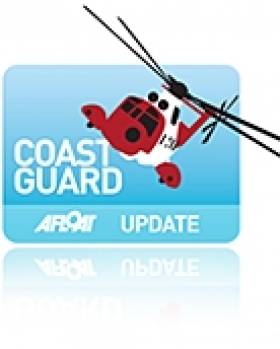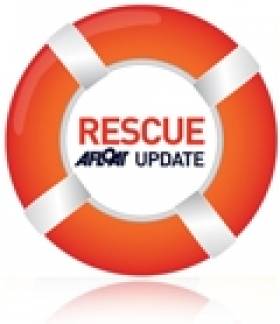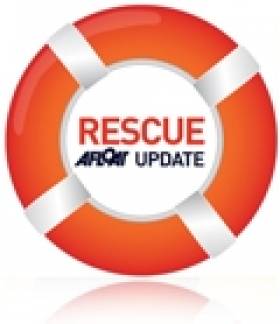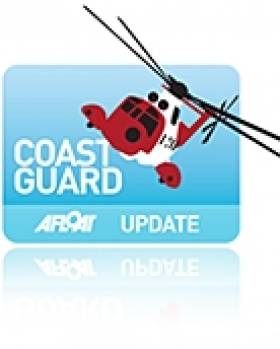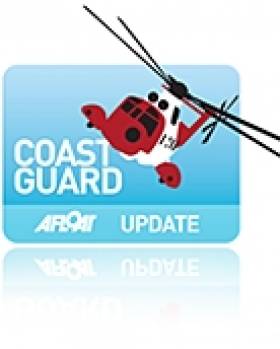Displaying items by tag: Fisherman
Injured Portuguese Fisherman Rescued Off Pembrokeshire Coast
#coastguard – A Portuguese fisherman has been taken to hospital after suffering a head injury on board a fishing vessel approximately 30 nautical miles west of St. Ann's Head.
Milford Haven Maritime Rescue Coordination Centre (MRCC) was contacted by the French authorities just before midday today to say a fisherman needed to be evacuated.
Watch keeping staff at Milford Haven MRCC tried to make contact with the vessel, but this was made difficult as those on board spoke little English. A member of staff from the MRCC who spoke French, managed to pass on some information.
The RAF search and rescue helicopter from Chivenor was sent to the scene but weather conditions proved too tricky for a winchman to be lowered on to the vessel to recover the casualty. The RNLI all-weather lifeboat from Angle was then requested to launch to meet with the vessel, which was asked to head closer to land to try to find calmer waters. HMS Echo also went to assist. The RAF helicopter returned to the scene and was then able to airlift the casualty and take him to Morriston Hospital in Swansea.
The wind at the time was blowing a south easterly gale force 8 (39-46 mph), with rough seas.
Barrie Yelland, Watch Manager at Milford Haven MRCC, said:
"Due to the weather conditions, this was a challenging rescue for all involved. It was made all the more difficult as those on board the fishing vessel couldn't speak English."
Body Recovered Off Dublin Thought to Be Missing Fisherman
#RESCUE - The Evening Herald reports that a body recovered 14km off the coast of north Dublin on Sunday is believed to be that of a missing fisherman.
The grisly find was made by the fishing vessel Rath Eilte in the waters off Skerries. A post-mortem was set to be carried out yesterday to determine the cause of death.
Found fully clothed in black and yellow oilskins, the remains are thought to be those of a Ukrainian in his 30s, a crewman on the Kilkeel-registered Zenith who was reported missing some 14.5km off Clogherhead in Co Louth on 29 January.
Search for Fisherman in Irish Sea Enters Second Day
#RESCUE - The Irish Times reports that the search has resumed for a fisherman who fell overboard from a trawler in the Irish Sea yesterday.
The crewman of the Kilkeel-registered fishing vessel Zenith was reported missing some nine miles (14.5km) off Clogherhead, Co Louth.
Yesterday afternoon the Irish Coast Guard and Clogherhead RNLI began an air and sea search and rescue effort, assisted by coastguard helicopter and other lifeboats and vessels in the area.
The Irish Times has more on the story HERE.
Efforts Continue to Locate Missing Fisherman on the Irish Sea
#MAN OVERBOARD – At 02.29 am, Holyhead coastguard received a call from a fishing vessel to report one of their crew missing, he had been last seen onboard 1.2 miles west of South Stack on the Irish Sea.
A mayday relay was broadcast by Holyhead Coastguard to alert other vessels in the area and RNLI lifeboats were requested to launch from Holyhead, Porthdinllaen, and Trearddur. A rescue helicopter was also scrambled from RAF Valley. Other fishing vessels in the area are also assisting in the search.
The fishing vessel had departed Holyhead at 11.25 pm and the crewman was last seen at 00.45 am, the vessel alerted Holyhead after finding the man missing at 02.29 am.
Holyhead Coastguard has coordinated the fishing vessels, lifeboats and helicopter in a search in Caernarfon Bay covering an area of fifty square miles.
Jim Green, Watch Manager, Holyhead Coastguard said:
Every effort has been made to try and locate this missing crewman.
The weather in the area is North Westerly F4 with a calm sea and slight swell, the water temperature is eight degrees.
The Coastguard say he was not wearing a lifejacket.
Air Corps Patrol Assists in Rescue of Injured Fisherman
#RESCUE - The Irish Times reports that an Air Corps maritime patrol aircraft joined a search and rescue mission to evacuate a fisherman off the West Cork coast today.
The Casa CN 235 - one of two operated by the Air Corps - diverted from its daily patrol to provide a communications relay in the operation to rescue an injured crewman from a Spanish fishing boat some 100 miles south of of Castletownbere.
The fisherman was airlifted by an Irish Coast Guard helicopter which at last report was taking him to medical attention in Cork.
Body of Irish Fisherman Recovered in Scotland
#NEWS UPDATE - A fisherman whose body was found in a Scottish harbour on St Stephen's Day has been identified as that of a 34-year-old Donegal man, the Belfast Telegraph reports.
Philip Anthony Toland, from Glengad in Inishowen, Co Donegal, was last seen on Christmas Day near the pier at Ullapool harbour in the Scottish Highlands.
As BBC News reports, concerns were raised later that evening and a search was launched involving police, coastguard and RNLI lifeboat teams.
The body was located by a police dive team in the sea near the pier when the search resumed on Monday morning.
It is being speculated that Toland - who has an eight-year-old son - may have slipped and fallen into the water while returning to his boat.
French Fishermen Rescued
At 9.45am Belfast Coastguard received the report of a man with abdominal pains from the fishing vessel 'Saint Gothard' south east of Strangford Lough. The skipper had spoken to a doctor who had advised that the 50 year old man should be taken to hospital as soon as possible.
It quickly became apparent that the crew did not speak English and so the French Coastguard from Maritime Rescue Coordination Centre in Gris Nez agreed to translate. Using three-way communications, which included satellite telephones and coastguard equipment, Belfast Coastguard, the crew of the Irish helicopter and the Coastguard at Gris Nez managed to communicate with the vessel, explaining how to set-up a high-line transfer and the best direction and speed of the vessel for the winchman. The sick crew man was successfully airlifted, by the Irish Coastguard helicopter in Gale force 8 winds and taken to hospital in Newry, Northern Ireland.
Belfast Coastguard, Watch Manager Steve Carson said:
"I'd like to thank our colleagues in Ireland and France for their help with this rescue, which ensured that a sick fisherman now has the medical attention he needs. "
Injured Fisherman Airlifted to Hospital by Shannon Coastguard
An injured man fisherman airlifted to hospital yesterday from a boat off Kerry coast, The Irish Times reports.
The Shannon-based Irish Coast Guard helicopter was dispatched to assist the crewmember on the UK-registered fishing vessel Achieve, some 110 miles southwest of the Blasket Islands.
He was airlifted to Tralee Regional Hospital, where he is being treated for serious injuries.
The incident marked the fourth time that the Shannon helicopter has been called into action this week.
This included its assistance of the crew of the yacht Rambler 100, which capsized near Fastnet Rock while competing in this year's Rolex Fastnet Race last weekend.
Body of Fisherman Found in Castletownbere
The body of a fisherman reported missing from a trawler at Castletownbere, Co Cork yesterday morning has been recovered.
Local divers teamed with the Castletownbere Lifeboat and the Irish Coast Guard for a search that ended around 1.30pm when the body of the 43-year-old was found in the water close to the pier.
The Irish Times reports that the man, who resident in Clogherhead, Co Louth, had been socialising with friends the night before and failed to return to the Patrick C, the trawler on which he was a crewman.
Crosshaven Lifeboat Recover Body in Ringabella Bay
Crosshaven RNLI Lifeboat report that they have recovered the body of a missing fisherman from the sea at Ringabella Bay after information received from a person on shore. The fisherman was lost when the fishing boat sank almost four weeks ago.
Related Safety posts
RNLI Lifeboats in Ireland
Safety News
Rescue News from RNLI Lifeboats in Ireland
Coast Guard News from Ireland
Water Safety News from Ireland
Marine Casualty Investigation Board News
Marine Warnings


























